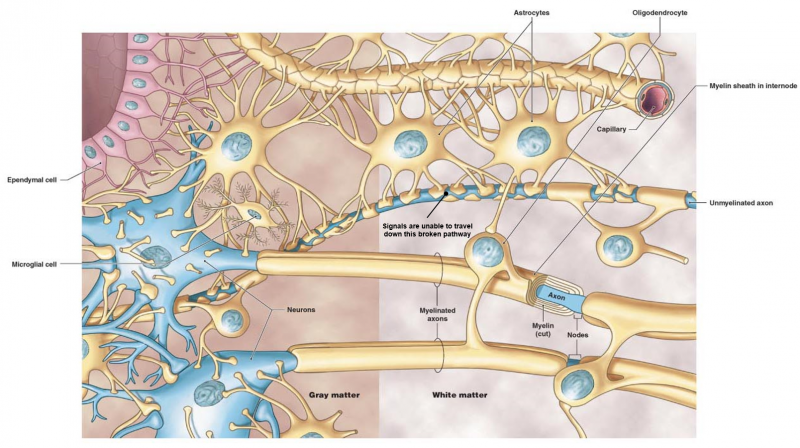The word Leukodystrophy comes from the Greek roots leuko (white), dys (lack of) and troph (growth). It refers to a group of genetic disorders affecting the myelin of central nervous system. Myelin is a fatty substance whose purpose is to insulate the nerve fibres found in the brain (central nervous system) as well as those that control all the muscles in our body (peripheral nervous system). The brain consists of grey matter and white matter. Grey matter contains nerve cells in regions of the brain involved in muscle control, sensory perception such as sight, sound, taste, touch and smell and memory and emotions. White matter contains the nerve fibres (wires) covered in a myelin sheath (insulation) which connect the grey matter and make the brain work as a whole. The myelin sheath has two functions: insulation and acceleration of impulse conduction. When myelin is not produced correctly, the nerves fibres short circuit and prevent nerve cells from sending messages to different parts of the body.
It is important to note that not all Leukodystrophies are primary myelin disorders. For example some may be due to sick nerve fibres which in turn effect the production of myelin. These are classified as Leukoencephalopathies which describes Leukodystrophy like conditions and can be applied to all white matter disorders whether their genetic or molecular cause is known or not.
All Leukodystrophies are degenerative, which means that the myelin sheath deteriorates at a rate that differs from one variant to another. That is why the physical condition of children affected by this disease can sometimes deteriorate very quickly. Leukoencephalopathies however are generally slower degenerative conditions and sometimes even static.
Hypomyelination vs. Demyelination vs. Dysmyelination
Hypomyelination is characterised by a defective structure and function of the myelin sheath in the brain and spinal cord. In Hypomyelinating disorders myelin was never made in sufficient amounts.
Example of Hypomyelination
– Hypomyelination with Brain stem and spinal cord involvement and Leg spasticity HBSL (Gene DARS)
Demyelination is the loss of the myelin sheath insulating the nerves. In demyelinating disorders due to an underlying metabolic condition, sometimes brought on by an external event such as febrile episode or head trauma, healthy myelin is initially formed and then breaks down. When myelin degrades, conduction of signals along the nerve can be impaired or lost and the nerves eventually wither causing lesions. This damage impairs the conduction of signals in the affected nerves. In turn, the reduction in conduction ability causes deficiency in sensation, movement, cognition, or other functions depending on which nerves are involved.
Example of a Demyelination
– Metachromatic Leukodystrophy MLD (Gene ARSA)
Dysmyelination is characterised by a defective structure and function of the myelin sheath. In dysmyelinating disorders myelin is formed incorrectly. Unlike demyelination, dysmyelination does not produce lesions. Such defective sheaths often arise from genetic mutations affecting the biosynthesis and formation of myelin. The shiverer mouse represents one animal model of dysmyelination.
Example of Dysmyelination
– Canavan Disease (Gene ASPA)





